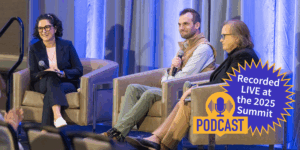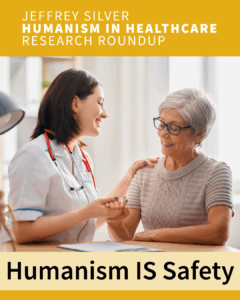The Jeffrey Silver Humanism in Healthcare Research Roundup features summaries of recently published studies on humanism in healthcare. To receive email notification of new studies once per month, enter your information here and select “Jeffrey Silver Research Roundup” from the checkboxes at the bottom. See previous posts in this series.
Publications from Gold Foundation-Affiliated Authors
Mapping the Landscape, Journeying Together: The Gold Foundation’s model for research-based advocacy in humanism in medicine (free full text)
Gaufberg, E. Acad Med. 2017 October.
Dr. Gaufberg is the Jean and Harvey Picker Director of the Gold Foundation Research Institute
In this invited commentary, Dr. Gaufberg describes Mapping the Landscape, Journeying Together (MTL) — an initiative of The Arnold P. Gold Foundation Research Institute. The MTL initiative awards teams with a grant to complete a rigorous review of the literature on a topic related to humanism in healthcare. Teams may then seek a discovery or advocacy grant to fill in gaps in knowledge or to make or advocate for change. Dr. Gaufberg reveals the MTL journey through the metaphor of cartography. She describes the initial development of a road map, as well as the MTL community’s experience of navigation, discovery, and exploration. MTL participants are not only incrementally adding to a complex body of knowledge but also actively cultivating a robust community of practice.
Inter-professionals’ definitions of moral resilience
Holtz H, Heinze K, Rushton C. J Clin Nurs. 2017 Aug 3.
Dr. Rushton is a Mapping the Landscape grantee
Researchers asked 184 inter-professional clinicians (as well as 23 professionals with backgrounds such as chaplaincy and non-healthcare providers) to provide definitions of the concept “moral resilience.” They found primary themes of integrity-personal and relational, and buoyancy. Subthemes were self-regulation, self-stewardship and moral efficacy.
Patient-clinician communication: American Society of Clinical Oncology Consensus Guideline
Gilligan T, Coyle N, Frankel RM, Berry DL, Bohlke K, Epstein RM, Finlay E, Jackson VA, et al. J Clin Oncol. 2017 Sep 11:JCO2017752311.
Drs. Frankel, Epstein and Jackson are Mapping the Landscape grantees
A multidisciplinary panel of experts provides recommendations on how to use effective communication to optimize the patient-clinician relationship, patient and clinician well-being, and family well-being. Guideline development involved a systematic review of the literature and a formal consensus process. Recommendations address specific topics, such as discussion of goals of care and prognosis, treatment selection, end-of-life care, facilitating family involvement in care, and clinician training in communication skills.
Other Publications
Effects of patient-centered communication on anxiety, negative affect, and trust in the physician in delivering a cancer diagnosis: A randomized, experimental study
Zwingmann J, Baile WF, Schmier JW, Bernhard J, Keller M. Cancer. 2017 Aug 15;123(16):3167-3175.
Ninety-eight cancer patients and 92 unaffected people were randomly assigned to view a video of a clinician delivering a first cancer diagnosis with either an enhanced patient-centered communication style or a low patient-centered communication style. Participants viewing an oncologist displaying the enhanced patient-centered communication were significantly less anxious than those watching the low patient-centered communication style. They also reported significantly higher trust in the physician.
Associations between physician empathy, physician characteristics, and standardized measures of patient experience
Chaitoff A, Sun B, Windover A, Bokar D, Featherall J, Rothberg MB, Misra-Hebert AD. Acad Med. 2017 Oct;92(10):1464-1471.
Data about the demographics and empathy scores of Cleveland Clinic physicians were examined in relation to data about the hospital’s consumer ratings (CG-CAHPS). Researchers found that women, specialty physicians, outpatient physicians and those with Doctor of Osteopathy degrees had higher empathy scores. Physicians in obstetrics-gynecology, pediatrics, psychiatry, and thoracic surgery also had higher empathy scores. Empathy was correlated with higher scores on multiple CG-CAHPS items, suggesting that improving physician empathy might play a role in improving patient experience.
Compassionomics: Hypothesis and experimental approach (free full text)
Trzeciak S, Roberts BW, Mazzarelli AJ. Med Hypotheses. 2017 Sep;107:92-97.
Compassionomics is the branch of knowledge and scientific study of the effects of compassionate healthcare. Authors hypothesize that compassionate care is beneficial for patients (better outcomes), healthcare systems and payers (lower costs), and healthcare providers (lower burnout) and describe a framework for hypothesis testing.
Job resources, physician work engagement, and patient care experience in an academic medical setting
Scheepers RA, Lases LSS, Arah OA, Heineman MJ, Lombarts KMJMH. Acad Med. 2017 Oct;92(10):1472-1479.
Physician work engagement is associated with better work performance and fewer medical errors; however, whether work-engaged physicians perform better from the patient perspective is unknown. Researchers collected patient care experience evaluations in two Dutch academic hospitals as well as information from physicians about their job resources and work engagement. They found that physician work engagement was not associated with patient care experience. However, from the physicians’ perspective, learning opportunities and autonomy were positively associated with work engagement.
Assessing medical professionalism: A systematic review of instruments and their measurement properties (free full text)
Li H, Ding N, Zhang Y, Liu Y, Wen D. PLoS One. 2017 May 12;12(5):e0177321.
In the last 30 years, various instruments have been used to assess medical professionalism. In this study, authors systematically reviewed 74 instruments from 80 studies and found that the overall methodological quality of these studies was unsatisfactory. Three instruments were recommended: Hisar’s instrument for nursing students, Nurse Practitioners’ Roles and Competencies Scale, and Perceived Faculty Competency Inventory.
Which physicians’ behaviors on death pronouncement affect family-perceived physician compassion? A randomized, scripted, video-vignette study
Mori M, Fujimori M, Hamano J, Naito AS, Morita T. J Pain Symptom Manage. 2017 Sep 5. pii: S0885-3924(17)30435-9.
Ninety-two people in Tokyo were shown two videos of death pronouncements: one with compassion-enhanced behaviors and one without. Participants said that the physicians who used compassion-enhanced behaviors were more compassionate and trustworthy. Authors recommend five behaviors during death pronouncement: initiate prompt examination; explain that the physician has received a sign-out; perform examination respectfully; ascertain the time of death with a wristwatch (not a smartphone); and reassure the families that the patient did not experience pain.
Finding purpose: Honing the practice of making meaning in medicine. (free full text)
Leveen L. Perm J 2017;21:17-048.
Practitioners and patients alike can benefit from structured opportunities to explore the expectations, assumptions, and emotions that shape our understanding of health and illness, and thus our experiences within the health care system. This article demonstrates how group discussions of poetry — something that might seem irrelevant to medical practice or physical wellness — can foster communication, connection, and collective reflection for physicians, interprofessional health care teams, and groups that include practitioners, patients, and families, allowing participants to once again find meaning in medicine.
Translating medical school social missions to student experiences
Ellaway RH, Van Roy K, Preston R, Greenhill J, Clithero A, Elsanousi S, Richards J, Labarda C, Graves L, Mammen M, Assayed AA, Willems S. Med Educ. 2017 Sep 26.
Researchers examined the social missions of eight medical schools from around the world. They wanted to see how these missions were expressed through each school’s medical education programs. They found substantial variation in how schools’ missions were incorporated into education and significant variation in how students perceived the social mission and its translation to their training experiences. Authors found that it was important for the schools to educate their learners about the mission and provide them with clinical experiences that embodied the issues the mission was seeking to address.




